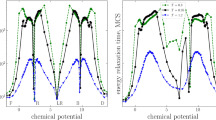Abstract
A discrete model of adsorption with allowance for recharge of the state and lateral interaction between molecules is constructed in the framework of the theory of probabilistic cellular automata. It is found that this model admits of the regular (ordered) behavior of the system accompanied by the global synchronization of the system’s parameters. The turbulent (chaotic)-ordered transition takes place through the occurrence of local ordered areas due to the appearance of local leading centers (pacemakers) and helical waves. The ordered behavior originates from intrinsic instability in the system. The ordering is related to the collective behavior of the subsystems constituting the entire system. The model can be extended to the case of chemical reactions between an adsorbate and the surface.
Similar content being viewed by others
References
A. W. Adamson, The Physical Chemistry of Surfaces, 4th ed. (Wiley, New York, 1982; Mir, Moscow, 1979).
F. Ozanam, J.-N. Chazalviel, A. Radi, et al., Phys. Chem. 95, 98 (1991).
J. Carstensen, R. Prange, G. S. Poprikov, and H. Föll, Appl. Phys. A 67, 459 (1998).
R. L. Smith and S. D. Collins, J. Appl. Phys. 71, R1 (1992).
E. Yu. Buchin and A. V. Prokaznikov, Pis’ma Zh. Tekh. Fiz. 23(5), 1 (1997) [Tech. Phys. Lett. 23, 244 (1997)].
D. Dini, S. Catarin, and F. Decker, in Proceedings of the International Conference “Porous Semiconductors: Science and Technology,” Mallorca, 1998, p. 13.
V. Parhutik, Y. Chu, Z. Nagy, and P. A. Montano, in Proceedings of the International Conference “Porous Semiconductors: Science and Technology,” Mallorca, 1998, pp. 16–17.
V. Parhutik and E. Matveeva, in Proceedings of the International Conference “Porous Semiconductors: Science and Technology,” Madrid, 2000, pp. 66–68.
V. Parhutik, E. Matveeva, I. Tkachenko, et al., in Proceedings of the International Conference “Porous Semiconductors: Science and Technology,” Madrid, 2000, pp. 297–298.
B. M. Kostishko and Yu. S. Nagornov, Zh. Tekh. Fiz. 71(7), 60 (2001) [Tech. Phys. 46, 847 (2001)].
Yu. E. Babanov, A. V. Prokaznikov, N. A. Rud, and V. B. Svetovoy, Phys. Status Solidi A 162, R7 (1997).
A. N. Laptev, A. V. Prokaznikov, and N. A. Rud, Pis’ma Zh. Tekh. Fiz. 26(23), 47 (2000) [Tech. Phys. Lett. 26, 1049 (2000)].
A. N. Laptev, A. V. Prokaznikov, and N. A. Rud, Mikrosist. Tekh., No. 6, 31 (2002).
D. I. Bilenko, O. Y. Belobrovaya, E. A. Zharkova, et al., Semiconductors 36, 466 (2002).
D. P. Bernatskii and V. G. Pavlov, Pis’ma Zh. Tekh. Fiz. 26, 22 (2000) [Tech. Phys. Lett. 26, 233 (2000)].
D. P. Bernatskii and V. G. Pavlov, Fiz. Tverd. Tela (St. Petersburg) 46, 1494 (2004) [Phys. Solid State 46, 1538 (2004)].
Yu. E. Babanov, A. V. Prokaznikov, and V. B. Svetovoy, Vacuum 41, 902 (1990).
S. A. Kaplii, A. V. Prokaznikov, and N. A. Rud, Pis’ma Zh. Tekh. Fiz. 30(14), 46 (2004) [Tech. Phys. Lett. 30, 595 (2004)].
Yu. A. Babanov, A. V. Prokaznikov, and V. B. Svetovoi, in All-Russia Conference with the Participation of Foreign Scientists “Mikroelektronika-94,” Zvenigorod, 1994, Chap. 2, pp. 593–594.
E. Yu. Buchin and A. V. Prokaznikov, Phys. Low-Dimens. Semicond. Struct. 7–8, 69 (2003).
V. S. Anishchenko, Complex Oscillations in Simple Systems (Nauka, Moscow, 1990) [in Russian].
H. Fuks, nlin.CG/0302015 (2003).
Y. Oono and M. Kohmoto, Phys. Rev. Lett. 55, 2927 (1985).
V. K. Vanag, Usp. Fiz. Nauk 169, 481 (1999) [Phys. Usp. 42, 413 (1999)].
G. Benettin, L. Galgani, and J.-M. Strelcyn, Phys. Rev. A 14, 2338 (1976).
I. O. Protod’yakonov and S. V. Siparov, Mechanics of Adsorption in Gas-Solid Systems (Nauka, Leningrad, 1985) [in Russian].
I. Vosilyus and L. Pranyavichyus, Ion-Beam-Activated Processes on Solid Surfaces (Mokslas, Vil’nyus, 1987) [in Russian].
A. Traulsen and J. C. Claussen, cond-mat/0404694 (2004).
S. A. Kaplii, A. V. Prokaznikov, and N. A. Rud, in Proceedings of the 2nd All-Russia Scientific Conference on the Design of Engineering and Scientific Applications in the MatLab Environment, Moscow, 2004, pp. 559–564.
S. Wolfram, Rev. Mod. Phys. 55, 601 (1983).
Author information
Authors and Affiliations
Additional information
__________
Translated from Zhurnal Tekhnichesko\(\overset{\lower0.5em\hbox{$\smash{\scriptscriptstyle\smile}$}}{l}\) Fiziki, Vol. 75, No. 12, 2005, pp. 1–9.
Original Russian Text Copyright © 2005 by Kapli\(\overset{\lower0.5em\hbox{$\smash{\scriptscriptstyle\smile}$}}{l}\), Prokaznikov, Rud.
Rights and permissions
About this article
Cite this article
Kaplii, S.A., Prokaznikov, A.V. & Rud, N.A. Discrete model of adsorption with a finite number of states. Tech. Phys. 50, 1535–1543 (2005). https://doi.org/10.1134/1.2148555
Received:
Issue Date:
DOI: https://doi.org/10.1134/1.2148555



